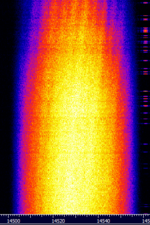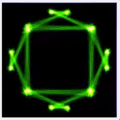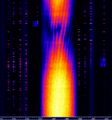Ultra Low Latency (ULL) Electronic Trading Network
This Ultra Low Latency (ULL) Electronic Trading Network is a 48k or 24k baudBaud (unit symbol Bd) is the unit for symbol rate or modulation rate in symbols per second. OQPSK signal that is strongly suspected (through numerous circumstantial pieces of evidence) to be either an experimental or active P2P RFRadio Frequency link between financial market data centers, used for High Frequency Trading (HFT) and other latency-sensitive market activities. Not much is known on exactly which commercial entity it belongs to, but the link is likely part of a Chicago <-> New York link to connect the NY and Chicago financial hubs.
It is an OQPSK signal with a baudBaud (unit symbol Bd) is the unit for symbol rate or modulation rate in symbols per second. rate of 48k or 24k. Due to natural fading on HFHigh Frequency (3-30 MHz) it is almost never seen at full strength with the natural PSKPhase-Shift Keying rounded amplitude shape. There is usually two of these signals present on HFHigh Frequency (3-30 MHz), one lower frequency than the other.
TDoA suggests that the signal is being transmitted outside of Chicago.
Frequencies[edit]
- 6840 kHzKiloHertz (kHz) 10^3 Hz
- 12145 kHzKiloHertz (kHz) 10^3 Hz
- 14325 kHzKiloHertz (kHz) 10^3 Hz
- 16240 kHzKiloHertz (kHz) 10^3 Hz
- 18250 kHzKiloHertz (kHz) 10^3 Hz
- 18300 kHzKiloHertz (kHz) 10^3 Hz
Additional Links[edit]
- Original Sample Source: i56578-SWL 48 KBaud OQPSK UNID Wideband Transmissions
- PETITION FOR RULEMAKING OF THE SHORTWAVE MODERNIZATION COALITION (Filed by some HFT players such as Jump Trading Group and Virtu Financial)
- FCC Experimental Radio Station License which overlaps with the frequencies and observed symbol rates found in this sample, and whose special conditions note 'market access' and 'market trial'.
- Another FCC Experimental Radio Station License with similar bands and symbol rates from the same company, which details a link between Washington State and Illinois, and whose special conditions are more explicit on nature: "This operation is not permitted for market trial or stock trading"
Media Documentation[edit]
- IEEE: Wall Street Tries Shortwave Radio to Make High-Frequency Trades Across the Atlantic
- Data Center Knowledge: Wall Street Going Wireless in Bid for Ultra-Low Latency



